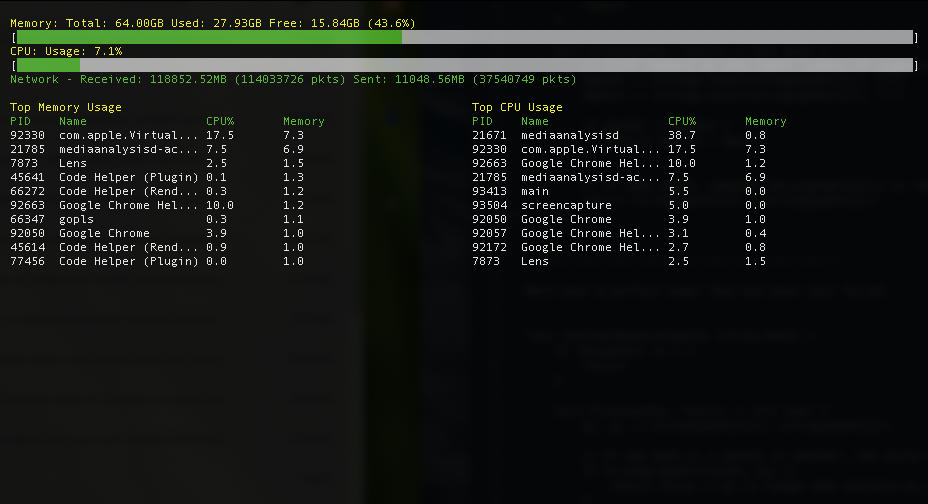Building a Real-time System Monitor in Go

I wanted to build a tool that shows me what’s happening on my system in real-time - CPU usage, memory consumption, network activity, and resource-hungry processes. Let’s build it together!
Understanding What We Need
To monitor a system, we need several pieces of information:
- Memory usage (total, used, free)
- CPU utilization percentage
- Network I/O statistics
- Running processes and their resource usage
Go has a great package called gopsutil that can give us all this information. Let’s explore what we need:
import (
"github.com/shirou/gopsutil/v3/cpu"
"github.com/shirou/gopsutil/v3/mem"
"github.com/shirou/gopsutil/v3/net"
"github.com/shirou/gopsutil/v3/process"
)Let’s see how each part works:
Memory Information
The mem package gives us memory statistics:
v, _ := mem.VirtualMemory()
fmt.Printf("Total: %v, Used: %v, Free: %v\n", v.Total, v.Used, v.Free)This gives us:
- Total memory (v.Total)
- Used memory (v.Used)
- Free memory (v.Free)
- Usage percentage (v.UsedPercent)
CPU Usage
The cpu package shows CPU utilization:
// Get CPU percentage (false = all CPUs combined)
percentages, _ := cpu.Percent(0, false)
cpuUsed := percentages[0] // Overall CPU usage percentageThe Percent() function:
- First argument (0) means immediate reading
- Second argument (false) means get total usage, not per CPU
- Returns percentage of CPU in use
Network Statistics
The net package provides network I/O information:
// Get network stats (false = all interfaces combined)
netStats, _ := net.IOCounters(false)
stats := netStats[0] // Overall network statistics
// Available fields:
// - BytesSent
// - BytesRecv
// - PacketsSent
// - PacketsRecvThis gives us sent/received bytes and packets across all network interfaces.
Process Information
The process package lets us see what each process is doing:
processes, _ := process.Processes()
for _, p := range processes {
name, _ := p.Name()
cpu, _ := p.CPUPercent()
mem, _ := p.MemoryPercent()
memInfo, _ := p.MemoryInfo()
}For each process we can get:
- Process name and PID
- CPU usage percentage
- Memory usage percentage
- Actual memory size (RSS - Resident Set Size)
Building Our Display
We want to show all this in the terminal, so we’ll use tcell for the UI:
import "github.com/gdamore/tcell/v2"Let’s create a structure to hold process information that we’ll display:
type ProcessInfo struct {
PID int32
Name string
CPU float64
Memory float64
MemSize uint64
}Now we can write a function to gather all process information:
func getProcessInfo() []ProcessInfo {
processes, _ := process.Processes()
var processInfo []ProcessInfo
for _, p := range processes {
name, _ := p.Name()
cpu, _ := p.CPUPercent()
mem, _ := p.MemoryPercent()
memInfo, _ := p.MemoryInfo()
if memInfo != nil {
processInfo = append(processInfo, ProcessInfo{
PID: p.Pid,
Name: name,
CPU: cpu,
Memory: float64(mem),
MemSize: memInfo.RSS,
})
}
}
return processInfo
}We want to show the top resource-using processes, so let’s add sorting:
func sortByMemory(processes []ProcessInfo) []ProcessInfo {
sort.Slice(processes, func(i, j int) bool {
return processes[i].MemSize > processes[j].MemSize
})
if len(processes) > 10 {
processes = processes[:10]
}
return processes
}
func sortByCPU(processes []ProcessInfo) []ProcessInfo {
sort.Slice(processes, func(i, j int) bool {
return processes[i].CPU > processes[j].CPU
})
if len(processes) > 10 {
processes = processes[:10]
}
return processes
}Putting It All Together
Now we have all the pieces to gather system information. Let’s create the main update function that will collect everything:
func updateScreen(screen tcell.Screen) {
screen.Clear()
width, height := screen.Size()
// Get memory stats
v, _ := mem.VirtualMemory()
memUsed := float64(v.Used) / float64(v.Total) * 100
// Draw memory bar with detailed info
drawBar(screen, 1, 1, width-2, "Memory", memUsed,
fmt.Sprintf("Total: %.2fGB Used: %.2fGB Free: %.2fGB (%.1f%%)",
float64(v.Total)/1024/1024/1024,
float64(v.Used)/1024/1024/1024,
float64(v.Free)/1024/1024/1024,
memUsed))
// Get and display CPU usage
c, _ := cpu.Percent(0, false)
cpuUsed := c[0]
drawBar(screen, 1, 3, width-2, "CPU", cpuUsed,
fmt.Sprintf("Usage: %.1f%%", cpuUsed))
// Get and display network stats
n, _ := net.IOCounters(false)
netStats := fmt.Sprintf("Network - Received: %.2fMB (%d pkts) Sent: %.2fMB (%d pkts)",
float64(n[0].BytesRecv)/1024/1024,
n[0].PacketsRecv,
float64(n[0].BytesSent)/1024/1024,
n[0].PacketsSent)
drawText(screen, 1, 5, netStats, tcell.StyleDefault.Foreground(tcell.ColorGreen))
// Get and display process information
processes := getProcessInfo()
drawProcessTable(screen, 1, 7, width/2-1, height-7, "Top Memory Usage", sortByMemory(processes))
drawProcessTable(screen, width/2+1, 7, width/2-2, height-7, "Top CPU Usage", sortByCPU(processes))
screen.Show()
}Adding Visual Components
Now that we can collect system metrics, we need to display them nicely. We’ll use the tcell library to create a terminal UI with:
- Progress bars for CPU and memory
- Formatted text for network stats
- Tables for process information
Let’s start with the basic text display function:
func drawText(screen tcell.Screen, x, y int, text string, style tcell.Style) {
for i, r := range text {
screen.SetContent(x+i, y, r, nil, style)
}
}This function is pretty straightforward - it puts text at any position (x,y) on the screen with a given style. We’ll use this as a building block for our more complex displays.
Next, let’s create nice-looking progress bars for CPU and memory:
func drawBar(screen tcell.Screen, x, y, width int, label string, value float64, stats string) {
barWidth := width - 2 // Leave space for [ and ]
filled := int(float64(barWidth) * value / 100)
// Draw the label and stats in yellow
drawText(screen, x, y, label+": "+stats,
tcell.StyleDefault.Foreground(tcell.ColorYellow))
// Draw the bar border and fill
screen.SetContent(x, y+1, '[', nil, tcell.StyleDefault)
for i := 0; i < barWidth; i++ {
char := ' '
style := tcell.StyleDefault.Background(tcell.ColorDarkGray)
if i < filled {
style = tcell.StyleDefault.Background(tcell.ColorGreen)
}
screen.SetContent(x+1+i, y+1, char, nil, style)
}
screen.SetContent(x+barWidth+1, y+1, ']', nil, tcell.StyleDefault)
}This creates a progress bar that looks like:
Memory: Total: 16.00GB Used: 8.50GB Free: 7.50GB (53.1%)
[██████████████████████ ]Now for displaying process information in a table:
func drawProcessTable(screen tcell.Screen, x, y, width, height int, title string, processes []ProcessInfo) {
// Draw table title in yellow
drawText(screen, x, y, title, tcell.StyleDefault.Foreground(tcell.ColorYellow))
// Draw column headers in green
drawText(screen, x, y+1, fmt.Sprintf("%-6s %-20s %-10s %-10s",
"PID", "Name", "CPU%", "Memory"),
tcell.StyleDefault.Foreground(tcell.ColorGreen))
// Draw each process row
for i, p := range processes {
if i >= height-3 { // Leave space for title and headers
break
}
drawText(screen, x, y+2+i, fmt.Sprintf("%-6d %-20s %-10.1f %-10.1f",
p.PID, truncateString(p.Name, 20), p.CPU, p.Memory),
tcell.StyleDefault)
}
}
// Helper to prevent long process names from breaking the layout
func truncateString(s string, length int) string {
if len(s) <= length {
return s
}
return s[:length-3] + "..."
}This creates tables that look like:
Top Memory Usage
PID Name CPU% Memory
1234 chrome 15.5 234.5
5678 vscode 12.3 185.7Making It Update in Real-time
We want our display to update every second. Let’s set up the main program structure:
func main() {
// Initialize screen
screen, err := tcell.NewScreen()
if err != nil {
fmt.Fprintf(os.Stderr, "%v\n", err)
os.Exit(1)
}
if err := screen.Init(); err != nil {
fmt.Fprintf(os.Stderr, "%v\n", err)
os.Exit(1)
}
// Clean up on exit
defer screen.Fini()
// Set default colors
screen.SetStyle(tcell.StyleDefault.
Background(tcell.ColorBlack).
Foreground(tcell.ColorWhite))
screen.Clear()
// Set up clean shutdown
ctx, cancel := context.WithCancel(context.Background())
defer cancel()
// Handle Ctrl+C gracefully
sigChan := make(chan os.Signal, 1)
signal.Notify(sigChan, os.Interrupt, syscall.SIGTERM)
// Start update loop
var wg sync.WaitGroup
wg.Add(1)
go func() {
defer wg.Done()
for {
select {
case <-ctx.Done():
return
case <-sigChan:
cancel()
return
default:
updateScreen(screen)
time.Sleep(1 * time.Second)
}
}
}()
// Handle keyboard input
for {
switch ev := screen.PollEvent().(type) {
case *tcell.EventKey:
if ev.Key() == tcell.KeyEscape {
cancel()
return
}
case *tcell.EventResize:
screen.Sync()
}
}
}This setup:
- Initializes the terminal screen
- Creates a goroutine that updates the display every second
- Handles window resizing
- Allows clean exit with ESC or Ctrl+C
Run the program and you’ll see:
- Top section: Memory and CPU bars updating in real-time
- Middle: Current network traffic statistics
- Bottom half: Two tables showing top processes by memory and CPU usage
- Everything updates automatically every second
- ESC or Ctrl+C to exit cleanly
The program gives us a clear view of system resource usage with a responsive, easy-to-read interface. You can leave it running to monitor system behavior or spot resource-hungry processes.
Full code available on GitHub.
